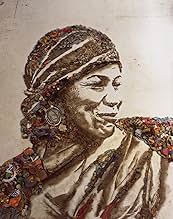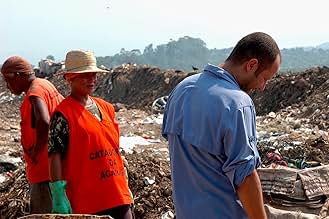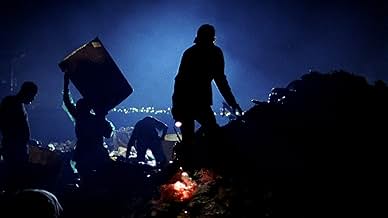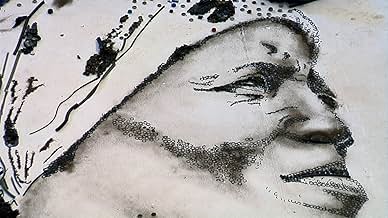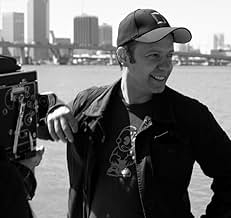Aggiungi una trama nella tua linguaOn the outskirts of Rio de Janeiro is Jardim Gramacho, the world's largest landfill, where men and women sift through garbage for a living. Artist Vik Muniz produces portraits of the workers... Leggi tuttoOn the outskirts of Rio de Janeiro is Jardim Gramacho, the world's largest landfill, where men and women sift through garbage for a living. Artist Vik Muniz produces portraits of the workers and learns about their lives.On the outskirts of Rio de Janeiro is Jardim Gramacho, the world's largest landfill, where men and women sift through garbage for a living. Artist Vik Muniz produces portraits of the workers and learns about their lives.
- Candidato a 1 Oscar
- 29 vittorie e 13 candidature totali
Recensioni in evidenza
This film has indeed reminded me that it is the one should have used the 4D gimmick which brazenly hyped by SPY KIDS: ALL THE TIME IN THE WORLD IN 4D (2011). With a bit odor touch, it could enhance more on the turmoil what we are watching in the landfill, and it is an extraordinary case that the sense of smell could actually have played a more essential role in the film genre.
Anyway, the environment-concerned stress has never been under the spotlight here, being a documentary about art and garbage pickers, one possible pitfall is the condescending inclination, but blithely it is not the case for this film, instead it spends most of time on the individual pickers who are involved in making this project, it captures many poignant moments behind their own stories. No doubt, Vik's work does have a pivotal role of altering the pickers lives, but the film does not overwhelmingly hinge on the process of making those artworks, and which perfectly encapsulates a more sublimated obligation in additional to a general aesthetic percipient, to change the world in a better way, and Vik and his team has done it, a tenacious and awe-inspiring job.
Apart from the riveting story, there are several panning scenes of the landfill are astonishing, our life is linking with garbages everyday, but most of us act like they are thoroughly vanishing from the earth after when they are being discarded in the dustbins. After watching this film, we might be coerced to face some soiled corner of our life which we are selectively and subjectively ignoring, and starts with the most basic one: behave yourself.
Making a living is what they made until Muniz changed the way they looked a recyclables. He bonded the artifacts with the humans and created memorable portraits of the pickers. A show in London, which they attended, became a catalyst for change in their lives and in the lives of spectators who had no idea Rio's garbage had become Rio's recyclables under the hands of these professional pickers.
Muniz makes sure no one condescends, no one feels sorry for his subjects, some of whom have never known anything but the landfill and others who have chosen it rather than deal drugs or prostitute themselves. Waste Land is as dignified a story about the potential of the poor class to rise out of its garbage and transform it into art and a better life. For this reason, Muniz can stand with the great humanitarians like Albert Schwitzer and Mother Theresa.
The catadores, who number in the thousands, work under burning hot sun and overpowering odors collecting and selling recyclable materials such as bottles, plastic, and metal to wholesalers and middlemen who turn them into such resalable items as buckets or bumpers for automobiles. Vic Muniz' plan is to select and paint a group of six catadores to pose as photographic subjects that will mimic such classic paintings as "The Death of Marat" by Jacques-Louis David. Money from sales of the resulting art will go to the pickers association for the benefit of the workers. The project included Tiao, the leader of ACAMJG (Association of Collectors of the Metropolitan Landfill of Jardim Gramacho) who went on a hunger strike to dramatize the conditions of the pickers and built an organization that helped create a skills-training center and a medical clinic for the workers.
There was also Zumbi, a member of the association, who began a library from his home from books that had been discarded, Irma, a cook who makes stews and roasts from edible meat to feed the workers, Suelem, an 18-year old girl who has been working in the garbage dump since she was only seven years old, and Valter, an elderly man who entertains with stories and songs and who decides to participate because he believes that "it will raise awareness of all us pickers." Once the initial photographs are made, Muniz projects an enlarged version of each photo onto the floor of his studio and hires the pickers to add refuse from the landfill onto the canvas, photographing the result from overhead. This then becomes the finished art work, ready to be exhibited at auctions and museums around the world with the pickers traveling to such cities as London and New York, the first time they have ever left Gramacho.
Waste Land is not only a biography of an artist, but a look at the artist in the context of the community in which his art is created. Muniz reveals the courage and resilience of the people in spite of their grinding poverty and depressing environment. Many are former middle class residents of the suburbs who chose the life of the picker rather than becoming prostitutes or drug dealers and are happy with their choice. Though Muniz's goal was, "to be able to change the lives of a group of people with the same material that they deal with every day," he never dreamed that his work would impact the lives of the people so dramatically.
Through his efforts, many of the residents who worked for him have changed their life and either reconciled with their families or gone on to more rewarding jobs. Modernization has also begun to take shape at Gramacho. A recycling plant has been built and the workers have been separated into categories for more efficient organization. Though admittedly just a beginning, Muniz has demonstrated that the power of art is available to all people regardless of their circumstances, allowing them to experience their inner beauty and believe in themselves in a new way. Not succumbing to the temptations of melodramatic excess, Waste Land has been shortlisted for an Oscar for Best Documentary and fully deserves to be among the finalists.
Lo sapevi?
- QuizThe Gramacho landfill was in fact deactivated in 2012. It is now a green area once again, wherein its native life has returned. However, many of the pickers forced into retirement were left without jobs and in poor quality of life.
- Citazioni
Valter: [talking about the importance of recycling] People sometimes say "But one single can?" One single can is of great importance. Because 99 is not 100, and that single one will make the difference.
- ConnessioniFeatured in The 83rd Annual Academy Awards (2011)
I più visti
- How long is Waste Land?Powered by Alexa
Dettagli
- Data di uscita
- Paesi di origine
- Siti ufficiali
- Lingue
- Celebre anche come
- Waste Land - L'arte del riciclo
- Luoghi delle riprese
- Jardim Gramacho, Rio de Janeiro, Brasile(landfill)
- Aziende produttrici
- Vedi altri crediti dell’azienda su IMDbPro
Botteghino
- Budget
- 1.500.000 USD (previsto)
- Lordo Stati Uniti e Canada
- 187.716 USD
- Fine settimana di apertura Stati Uniti e Canada
- 9806 USD
- 31 ott 2010
- Lordo in tutto il mondo
- 291.307 USD
- Tempo di esecuzione
- 1h 39min(99 min)
- Colore
- Mix di suoni
- Proporzioni
- 1.85 : 1



